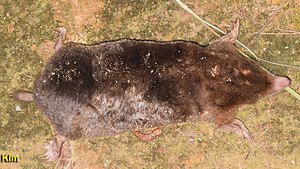Ussuri mole
| Ussuri mole | ||||||||||||
|---|---|---|---|---|---|---|---|---|---|---|---|---|

Ussuri mole ( Mogera robusta ) |
||||||||||||
| Systematics | ||||||||||||
|
||||||||||||
| Scientific name | ||||||||||||
| Mogera robusta | ||||||||||||
| Nehring , 1891 |
The Ussuri mole ( Mogera robusta ) is a species of mammal from the genus of the East Asian moles within the moles (Talpidae). It is distributed over parts of northeast China to Russia and Korea.
features
The Ussuri mole is a comparatively large type of mole with a head-trunk length of 17.0 to 22.0 centimeters and a very short tail length of 1.9 to 2.3 centimeters. The rear foot length is 22 to 24 millimeters, there are no external ears. The subspecies Mogera robusta coreana is significantly smaller with a head-trunk length of 14.0 to 17.0 centimeters. The Ussuri mole is the largest type of mole in China. The fur on the back is brown-gray with a metallic sheen, the underside of the nose is somewhat paler and more yellowish. The ventral side is shiny, silvery with a yellowish tinge, on the throat partly pale gray. The feet and claws are yellow, the front feet are very large with strong, shovel-like claws. The short tail is very hairy.
| 3 | · | 1 | · | 4th | · | 3 | = 42 |
| 3 | · | 0 | · | 4th | · | 3 |
The skull of the Ussuri mole reaches a total length of 37 to 48 millimeters (in Mogera robusta coreana less than 37.5 millimeters). It is stocky and blunt with a broad snout region. The nasal region is large and slightly raised. The first lower premolar is greatly enlarged, triangular, and has a double root.
distribution
The distribution area of the Ussuri mole covers parts of the northeast of the People's Republic of China and extends to Siberia and Korea . The species was detected in two subspecies in the provinces of Liaoning , Henan , Anhui , Heilongjiang and Jilin .
Way of life
Very little data is available on the way of life of the Ussuri mole. The species occurs in mountain forests, forest regions, meadows and agricultural areas. Like all moles, the Ussuri mole lives underground and digs tunnels in the ground where it feeds on insects, centipedes, and worms. The corridors reach total lengths of up to 4.50 meters and the main tunnels are located up to 30 centimeters below the ground, search corridors can be significantly closer to the surface at 8 to 10 centimeters. The corridors connect the foraging and watering holes.
The mating season of the animals begins at the end of March. The females give birth twice a year in April and July and have two to eight young animals per litter. The service life can be up to four years.
Systematics
The Ussuri mole is a separate species within the East Asian moles (genus Mogera ). The first scientific description comes from Alfred Nehring from 1891. The Ussuri mole is sometimes classified as a synonym and subspecies of the Japanese mole ( Mogera wogura ). However, according to a study from 2019, both species are clearly separated from molecular genetic and karyological ones . Sometimes Mogera wogura kobeae , the largest subspecies of the Japanese mole, was combined with Mogera robusta to form one species.
Within the species, a distinction is made between the nominate form Mogera robusta robusta and the subspecies Mogera robusta coreana , which is partially regarded as an independent species Mogera coreana . According to the study from 2019, both forms separated genetically in the transition from the Middle to the Upper Pleistocene 180,000 to 40,000 years ago, which, according to the authors, speaks more for a subspecies status.
Hazard and protection
The species is classified by the International Union for Conservation of Nature and Natural Resources (IUCN) as not endangered ("least concern") due to its large distribution area and the assumed high population numbers. There are no known threats to the stocks.
supporting documents
- ↑ a b c d e f g Large Mole. In: Andrew T. Smith , Yan Xie (Eds.): A Guide to the Mammals of China. Princeton University Press, Princeton NJ et al. 2008, ISBN 978-0-691-09984-2 , pp. 324-325.
- ↑ a b c Mogera robusta in the Red List of Threatened Species of the IUCN 2017-2. Listed by: Andrew T. Smith , CH Johnston, 2008. Retrieved December 31, 2017.
- ↑ a b c Mogera wogura . In: Don E. Wilson , DeeAnn M. Reeder (Eds.): Mammal Species of the World. A taxonomic and geographic Reference. 2 volumes. 3. Edition. Johns Hopkins University Press, Baltimore MD 2005, ISBN 0-8018-8221-4 .
- ↑ a b Elena Zemlemerova, Alexey Abramov, Alexey Kryukov, Vladimir Lebedev, Mi-Sook Min, Seo-Jin Lee, Anna Bannikova: Genetic and morphologic diversity of the moles (Talpomorpha, Talpidae, Mogera) from the continental Far East. Journal of Zoological Systematics and Evolutionary Research 57, 2019, pp. 662-678, doi: 10.1111 / jzs.12272
literature
- Large mole. In: Andrew T. Smith , Yan Xie (Eds.): A Guide to the Mammals of China. Princeton University Press, Princeton NJ et al. 2008, ISBN 978-0-691-09984-2 , pp. 324-325.
Web links
- Mogera robusta inthe IUCN 2017-2 Red List of Threatened Species . Listed by: Andrew T. Smith , CH Johnston, 2008. Retrieved December 31, 2017.